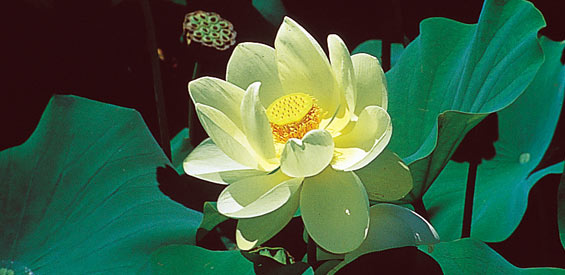>
More than 150 species of lotus exist, but few are commonly available. These include dwarf lotus (Chawan Basu), wild lotus (Nelumbo Lutea), hybrid variations of Nelumbo nucifera and Chinese lotus (Momo Botan).
The lotus flower was significant in ancient Egyptian culture and its image can be seen on many works of art from that era. Viable lotus seeds have been found that are over 2000 years old! Lotus leaves are waterproof. After a rain, you can observe the water bead up, as if the leaves have been waxed.
Care
When setting up the lotus root tubers, you will need a container at least 36" in diameter. Place 4-5" of
aquatic soil in the bottom (no compost, no organic matter) and no more than 3 tubers into the soil with the delicate growing tips up. It is vital that you do not touch any delicate new growth. Place an inch of soil over the tubers, taking care with new growth, then slowly pour water into container. Keep in mind that the lotus will grow much faster if you don't put it into the pond until it starts forming leaves.
| Interesting Facts: |
| Origin: |
Ancient Egypt, India. |
| Size: |
Depends on variety; Chawan Basu (dwarf) has 8-12" leaves, Momo Botan (Chinese) has 12-15" leaves, and Nelumbo Lutea (wild) has leaves that may grow up to 18 inches. |
| Climate Preference: |
Zone 5 and up, but can be grown as an annual in colder climates.. |
| Sunlight: |
A minimum of 6 hours per day. The more sun lotus get, the more they will bloom. |
| Depth: |
18" or shallower. |
| Lifespan: |
The lotus will probably be the last thing to begin to grow in your pond. Blooms last up to three days. The lotus is a perennial, which means once it has taken hold in your pond, it should bloom for years. |
| Form you will receive: |
Lotus are delivered as root tubers. |
|
|